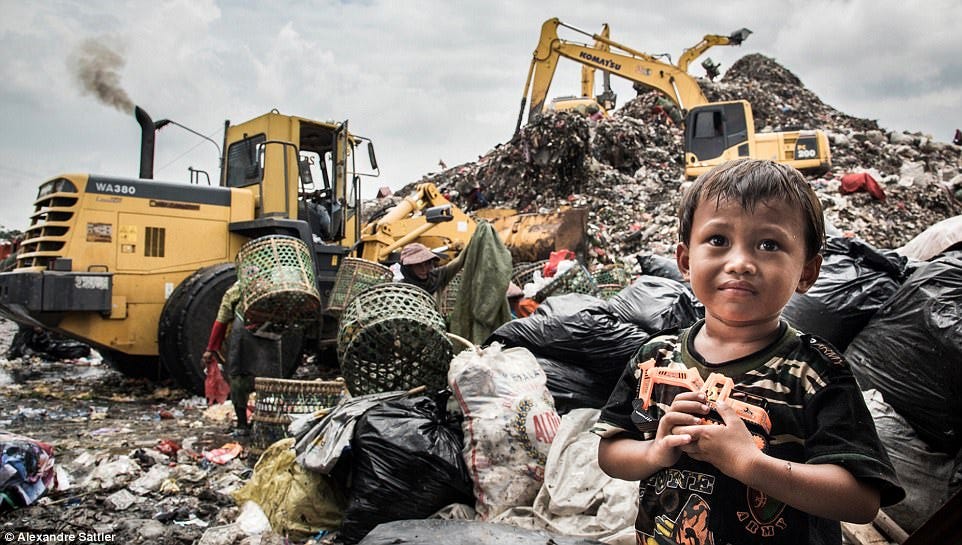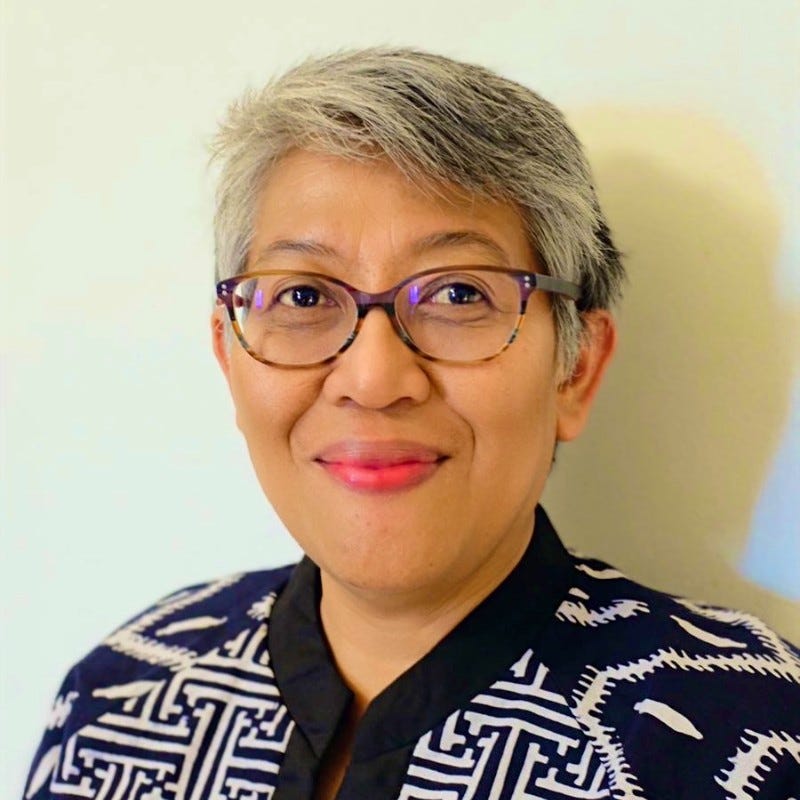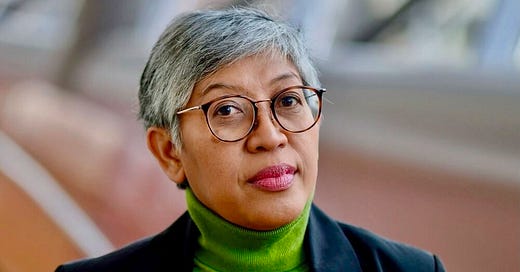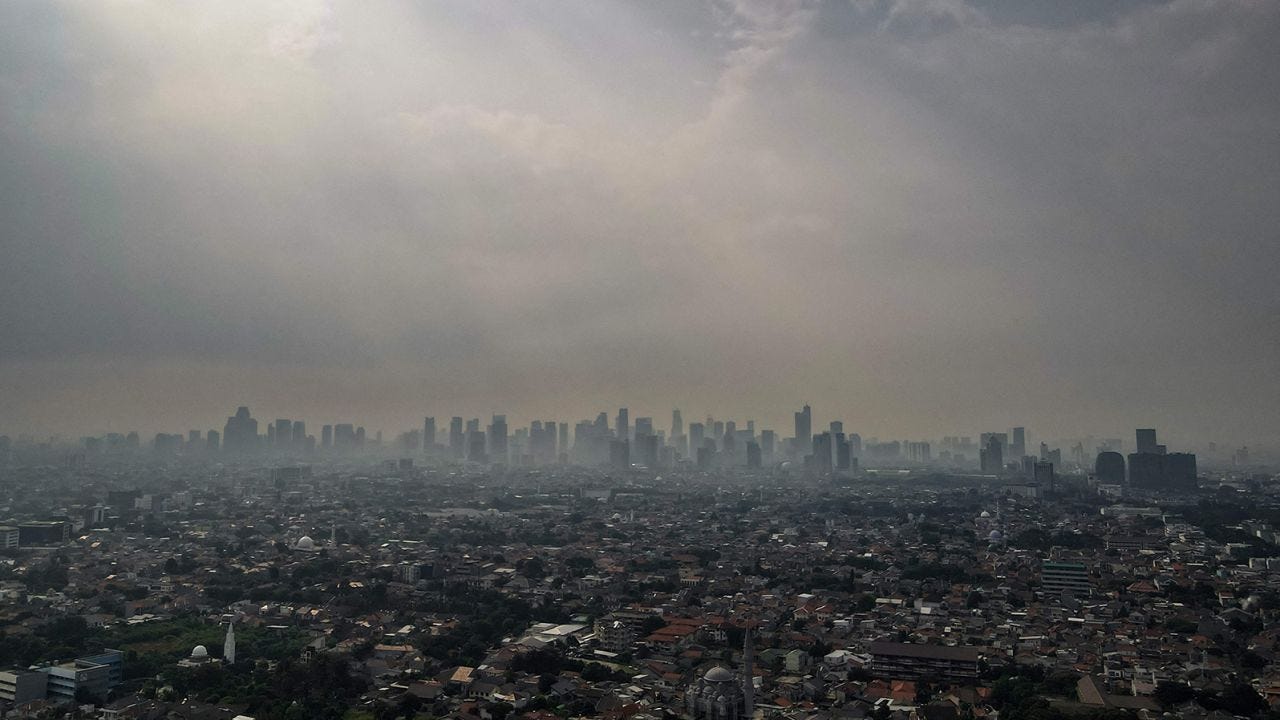Unmasking the Myth of Sustainable Waste Management
A Conversation with Yuyun Ismawati Drwiega on PFAS, Textile Waste, and Environmental Justice
Environmental health expert Yuyun Ismawati Drwiega offers a critical Global South perspective on waste management practices in this special Fafafoom Studio Newsletter March 2025 issue. From battling Jakarta's air pollution in landmark citizen lawsuits to exposing the toxic reality of "circular economy" practices, she offers a critical perspective from the Global South that challenges dominant narratives about sustainability, waste management, and the hidden chemical threats in our everyday products.
To account for my irregular schedule this month, this article will be free until the end of April 2025. Afterwards, it will be accessible to paying subscribers only on Substack. Enjoy!
Diverting textile from landfills is something I’m passionate about in my practice as an upcycling artist. In California, USA where I live, even textile waste is a growing challenge, accounting for “3% of total landfill waste, and the fifth most common material overall.” (CalPSC) Beyond California, I have examined insights for textile waste reports, both in the US and world stage. However, they are seen through the lens of first-world sustainability initiatives and circular economy models.
However, something was missing: the crucial perspective of those living where our discarded clothing actually ends up. So when I connected with Yuyun Ismawati Drwiega, co-founder of Nexus3 Foundation (formerly BaliFokus Foundation), I was really excited. She is an Indonesian environmental engineer who has spent nearly 25 years on the frontlines assessing environmental health impacts, developing sustainable community-based waste and sanitation management programs in Indonesia.
Through this interview, I discovered a powerful voice exposing the other side of our fashion waste stream, and I am honored to share her perspective with you all, readers. Her firsthand experience with what happens when shipping containers of second-hand textiles arrive at Indonesian ports reveals uncomfortable truths about waste colonialism and the toxic legacy of our consumption habits.
Author’s note: Because she lives in the UK, I’m preserving the British English spelling of her responses in its entirety.
Mira Musank (Mira): Mbak* Yuyun, thank you so much for doing this Q&A with me. Please introduce yourself and share how you came to become a leading voice in environmental health.
*Mbak: a word from Bahasa Indonesia of Javanese origin, literally translated to older sister. I used it as a loving, casual way to address an older sister not necessarily related by blood, and to identify Javanese as one of my cultural identities.
Yuyun Ismawati Drwiega (Yuyun): I'm Yuyun Ismawati, co-founder and Senior Advisor of the Nexus for Health, Environment and Development Foundation (Nexus3 Foundation), formerly the BaliFokus Foundation. I co-founded my organisation in 2000. I witnessed many cases and impacts of so-called development on people's health and the environment.
We look forward to our 25th anniversary reflections and revisiting our contributions to a better, just, toxics-free, and sustainable future.
Mira: I love that your LinkedIn profile includes this statement “Born at 319.62 ppm.” (Readers, you can check how much carbon was in the atmosphere when you were born.) It’s a simple yet brilliant idea to encourage people to think about air pollution in a more conscious manner. A 2021 study mentions that almost 9 million people die prematurely each year because of air pollution linked to fossil fuels.
This is nearly as many as people who died from cancer, and more than death due to firearms, warfare, and tobacco combined. Would you say that air pollution has been discussed thoroughly in your experience, or is it still a largely overlooked topic?
Yuyun: Air pollution, indoors and/or outdoors, is one of the major causes of non-communicable diseases. When we inhale pollutant particles in fine and ultrafine sizes, they go directly to our lungs and blood circulation system.
People undermined the severe impact of air pollution on our bodies, especially on children. Many experts have confirmed the long-lasting effects of air pollution on children’s health until later in life. Children are not mini-adults. Their organs are still developing until they are 18 years old. If they got interrupted or exposed to pollution, even inside the womb, they could formulate various diseases affecting their potential development, hormones, and nerve systems. That's why I joined the citizen lawsuit with 31 plaintiffs who demanded cleaner and better air quality in Jakarta.
Thousands of new chemicals are produced and used in various products every year. In developing countries, the emissions and releases of chemical cocktails to the air, water, and soil from manufacturing until the product's end-of-life are not well studied—a lack of laboratory capacity results in a lack of vigorous monitoring and health-protected standards. The high cost of installing proper air pollution control and its following disposal treatment are the main challenges of industries in the global South.
The WHO has already set tighter standards for PM2.5 and PM10, which are more protective than before. Every country must adopt these health-related standards to protect its citizens. However, many countries still use the old standards for various reasons.
Mira: I saw your interview with Al Jazeera on Instagram. I was really excited to see you, an environmental health expert who comes from one of the countries largely impacted by Global North’s waste exports. You talked about waste colonialism and the myth of “demand” that Global South has for the Global North’s waste. Would you explain to Fafafoom Studio Newsletter readers about this?
Yuyun: Thank you for watching my interview with Al Jazeera. I shared my observations with the audience and highlighted that we are trapped in ‘sustainable’ consumption and production (SCP) patterns, the 12th target of the Sustainable Development Goals (SDGs). Between 2009 and 2010, I participated in a series of discussions of SCP and contributed to establishing agreed-upon global targets and indicators.
Many delegates and the public understand that our overconsumption lifestyles are unacceptable and we don't have finite resources. That's why SCP was included in the target of SDGs.
However, circular economy terms are now more popular as an approach to continuing production and consumption patterns without considering the sustainability of the process. In the beginning, the idea of circularity is almost similar to the SCP patterns; however, with the addition of the word ‘economy’, the approach seems to emphasise the circularity for the sake of money or economy rather than to achieve a sustainable planet.
I refuse to use the term circular economy (CE) because it is not supported by a vigorous consultation process like a global agreement norm and does not have agreed global indicators to achieve the targets.
The Circular Economy also failed to recognise the toxic chemicals aspect of every product. Our studies with IPEN participating organisations in several countries, including in the African region, revealed that toxic chemicals are found in high concentrations in the recycled products, such as kitchen utensils, children's products and toys.
Products sold in black plastic colour showed the highest toxic content as they are made of low-grade or cheap plastic products. Many harmful plastic chemicals accumulate in the next products. Further, the burning of plastics also poisoning our food chain. This process leads to a toxic circular economy.
To perpetuate the ‘circular economy’ of everything, including waste trade and dumping practices of plastic wastes as well as textile waste, traders and economic advisors convinced policy makers that there are markets for everything they want to rid off in the global North. The destination is, of course, in the global South.
Traders, brokers and corrupt authorities take advantage of this situation and create false demands to continue their businesses. This scheme creates a new face of colonialism as the developed countries’ waste ‘occupied’ empty spaces or poor neighbourhoods in the developing world.

Mira: What do you think causes this discrepancy of understanding about the state of overconsumption and waste between the Global North (the waste dumpers) v. the Global South (the dumping grounds)?
Yuyun: There are complex dynamics that cause the discrepancy of understanding about the state of overconsumption and waste between the Global North and the Global South.
The economic growth globally is measured, among others, by a country's wealth and consumers’ purchasing power. The global North has the advantage of setting the trade rules and historic colonization that continued until now but taking shapes in a different form.
On the other hand, many countries in the global South have been following the industrialisation and economic pathways of the global North without taking the lessons from their mistakes. Most low-income countries or countries with economic transitions, try to follow the progress achieved by developed countries and use the words ‘the rights to development’. The economic growth visions in the global North accelerates the extraction of resources in the global South to satisfy the overconsumption of their populations.
However, when cheap products are exported from developing countries to developed countries, the only ‘commodities’ that are worth a trade-off from the North to the South are waste. Further, proper waste handling in developed countries is more expensive than dumping it in poor countries or in countries with lax regulations. This dynamic creates the imbalance of trade and waste dumping.

Mira: Would you share some insights about what actually happens to trailers filled with second hand textile imports from Europe or USA after they arrive in Indonesian ports?
Yuyun: In the last couple of years there have been many cases of illegal importation of worn clothing or second-hand textiles in Indonesia (HS code 6309). They were smuggled through small ports and Indonesia-Malaysia borders or used different commodity codes (not HS 6309) which made it difficult for the Customs officers to detect at the borders or ports. However, Malaysia imported it mostly from Japan and South Korea. The second-hand textiles import was resale in thrift stores or markets all over the country.
The EU exported worn clothing mostly to Cameroon, UAE and Belarus, while the USA mostly exported it to Latin American countries. Indonesia imported second-hand textiles mostly from Malaysia, legally and illegally, through several ports and porous borders. In the last couple of years, hundreds of tonnes of second-hand textiles worth more than 20 millions US dollars were smuggled to Indonesia.
Last year many thrift shops were raided and shipping containers confiscated. As stipulated by the law, illegal goods must be destroyed. In Indonesia, they burned the illegal goods in open burning to be witnessed by the public prosecutors not following the environmental sound management practices. However, the law does not consider the chemical content in textiles and textile products, such as PFAS.
Currently there are no measures established to control the destruction of illegal evidence in a safe way. The Attorney General’s guidance to handle confiscated goods containing hazardous substances is still to be tested as they are not a technical guidance document.
Mira: Is any of the imported textile waste recycled in Indonesia?
Yuyun: I haven’t found any actors or entrepreneurs who invested in imported textile waste to be recycled into new products in Indonesia. However, there are several entrepreneurs who developed their business using used/waste textiles, like Sleep Buddy, and PT Pan Brothers.
Mira: You mentioned to me about the dangers of textile recycling when not done thoughtfully - toxic PFAS need to be extracted before any type of recycling is done, otherwise the resulting recycled material will have a higher concentration of PFAS. Would you expand more on that?
Yuyun: PFAS per- and polyfluoroalkyl substances (PFAS) are a type of persistent organic pollutant (POP) toxic chemicals that are toxic to humans, animals, and the environment
When products containing PFAS are being recycled to make new products as it is, most likely, the toxic chemicals will be accumulated in new products. However, it’s not easy to get rid of PFAS from a product before they get recycled. It will involve high temperatures or electrochemical processes that will need careful operation and disposal systems to safely contain the collected PFAS.
Mira: Do you know if recycling facilities care enough about removing these toxic chemicals before recycling textile waste?
Yuyun: If the country where the factory is located has already a strong regulation in place and the industry has sufficient resources, maybe it’s possible. But when there is no regulation to enforce, no resources and no enabling system that makes the industry as well as consumers aware about the toxic chemicals in textiles and textile products, nobody cares.
-

Thank you so much Mbak Yuyun for her deep perspectives about the reality of waste management in Indonesia. Please support her work at Nexus3 Foundation; consider making a donation today.
There are so many more questions - the states of bioplastics, regulations against waste dumping, what kind of ripple effects the EU’s proposed PFAS ban on consumer products would have, and so much more.
Perhaps you, the reader, can add your opinion and learned insights in the comment sections, too!
Thanks for reading; until next time,
Mira Musank






